Driving to Rocky Point, also known as Puerto Peñasco, in Sonora, Mexico, is a popular getaway for many, especially those in Arizona and neighboring states. The ease of access via the Lukeville-Sonoyta border crossing makes it an attractive destination for beach lovers and adventure seekers. However, a common question arises for those planning a trip: “Is Rocky Point safe?”
After a temporary border closure in late 2023 that caused significant disruption, the Lukeville crossing is now open and operating normally. People are understandably concerned about safety, given widely publicized travel advisories for Mexico. Let’s address these concerns and provide you with essential information to ensure a safe and enjoyable trip to Rocky Point, Sonora, Mexico.
Understanding Travel Advisories for Sonora, Mexico
It’s true that the U.S. State Department issues travel advisories for various regions around the world, including Mexico. Sonora, the state where Rocky Point is located, often falls under an advisory to “reconsider travel.” This can sound alarming, but it’s crucial to understand the context.
These advisories are broad and apply to entire states, which, in the case of Sonora, is a large area. The advisory is not specifically targeted at the well-traveled Highway 8 corridor between Lukeville, Arizona, and Puerto Peñasco. For years, visitors have largely traveled this route without incident, aside from occasional encounters with Mexican police, which we’ll discuss further.
By exercising common sense and adhering to basic safety precautions, driving to Rocky Point via Highway 8 can be a safe and straightforward journey. Here are some essential tips for a safe drive:
- Stick to Highway 8: This highway is the most direct and safest route from Lukeville to Rocky Point.
- Drive during daylight hours: Avoid driving at night for increased safety and visibility.
- Respect speed limits: Overspeeding can attract unwanted attention and increase risks.
- Leave firearms and ammunition at home: Bringing weapons into Mexico is illegal and carries severe consequences.
- Avoid illegal substances: Drug use can lead to serious legal trouble and safety risks.
While the State Department’s map color-codes Sonora as ORANGE, urging Americans to “Reconsider Travel,” remember this applies to the entire state, not necessarily the specific route to Rocky Point.
General Safety in Mexico: Putting Things in Perspective
Concerns about safety in Mexico are often amplified by media coverage of isolated incidents. It’s important to remember that Mexico is a vast country with diverse regions. Safety concerns can vary significantly from one area to another.
Incidents like the 2023 kidnapping of four Americans near Brownsville, Texas, understandably raise alarms. However, such events, while tragic, are not representative of the overall safety situation in tourist destinations like Rocky Point. In that particular case, it was revealed to be a case of mistaken identity by a drug cartel, who even took action against their own members involved.
The U.S. State Department’s travel advisory system categorizes countries and Mexican states with colors:
- RED: Do Not Travel
- ORANGE: Reconsider Travel
- YELLOW: Exercise Increased Caution
- NO COLOR: Normal Caution
Currently, six Mexican states are labeled “Do Not Travel,” and seven, including Sonora, are under “Reconsider Travel.” It’s crucial to check the specific advisory details for each state to understand the nature of the risks and whether they pertain to your intended destination within that state.
 Mexico State Department Travel Advisory Map
Mexico State Department Travel Advisory Map
Driving to Puerto Peñasco: Sticking to the Safe Route
The State Department’s advisory for Rocky Point, or Puerto Peñasco, mentions “criminal activity and kidnapping” as reasons to “Reconsider Travel.” However, their advisory also notes that such crime is less frequent in tourist areas and beach locations.
The key advice for driving to Rocky Point is to use Highway 8, which runs directly from Sonoyta to Puerto Peñasco, and to travel during daylight hours. This route is considered significantly safer than Highway 2, especially for tourists heading to Rocky Point. Highway 2 is generally advised against, particularly for those driving from Nogales. The Lukeville/Highway 8 route remains the recommended and safest option.
Rocky Point remains a fantastic destination, especially for families in Arizona. It’s an easily accessible 3.5-hour drive from Phoenix, offering beautiful beaches along the Sea of Cortez and a growing selection of resorts and activities.
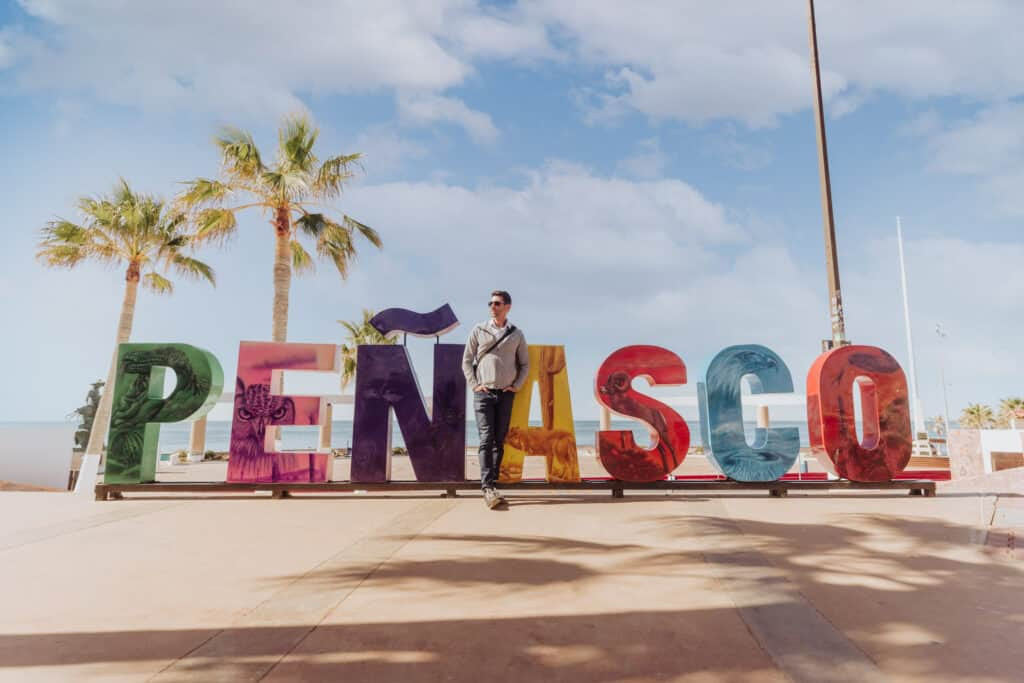 Welcome Sign to Puerto Peñasco, Mexico
Welcome Sign to Puerto Peñasco, Mexico
Deadly Incidents on Highway 2: Why to Avoid It
While Highway 8 has remained relatively safe, there have been tragic incidents on Highway 2, reinforcing the advice to avoid this route. Between December 2023 and Fall 2024, there were three separate deadly incidents involving Americans on Highway 2, none on Highway 8.
- December 2023: A shooting on Highway 2 between Altar and Santa Ana resulted in one death.
- July 2024: Two women were fatally shot while driving on Highway 2 after crossing at Lukeville but deviating towards Caborca.
- October 2024: An Arizona Marine was killed on Highway 2 near Altar while traveling from Nogales to Rocky Point.
These incidents, marked in red on the map below, all occurred on Highway 2, highlighting the increased risk associated with this route compared to the safer Highway 8.
What to Expect at the Mexican Border: Lukeville Crossing
Crossing the border at Lukeville into Sonoyta is generally a straightforward process. A video demonstration can show you exactly what to expect, easing any anxieties about your first border crossing.
Typically, the Lukeville crossing is not overly busy, with relatively short wait times, often around 10 minutes. While crime is a concern in certain areas of Mexico, for many travelers, the more immediate concern is potential interaction with Mexican police. We’ll delve into this aspect shortly.
Driving across the border into Mexico is often simpler than many first-timers anticipate. The Lukeville crossing is usually efficient and less congested than larger ports of entry.
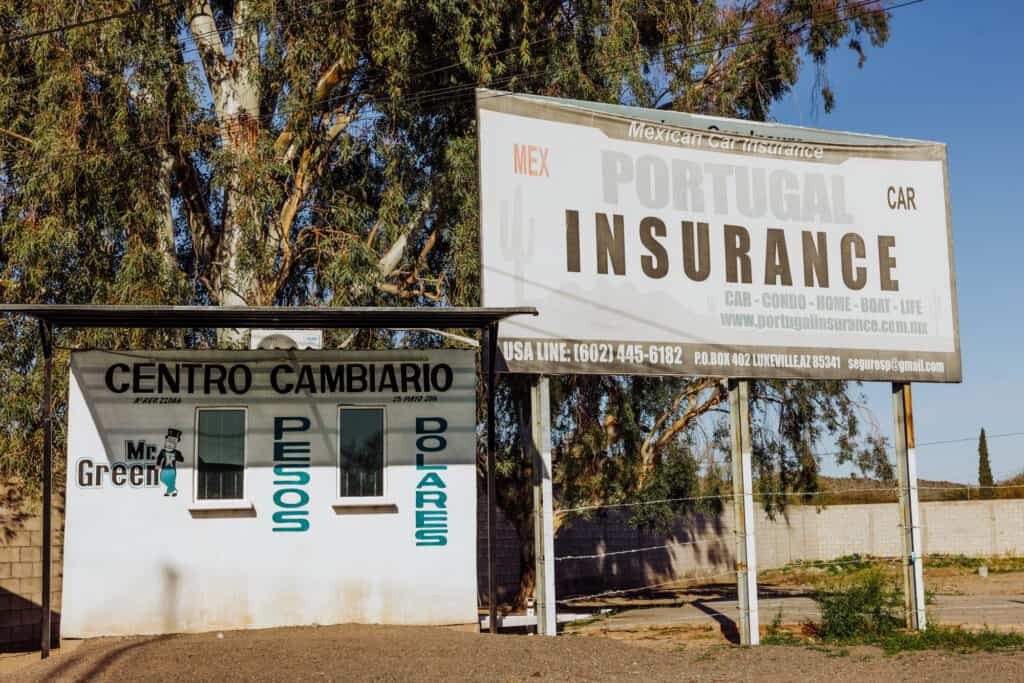 Mexican Insurance Storefront near the Border
Mexican Insurance Storefront near the Border
Pro-Tip: Before you go, check border wait times online to plan your crossing for less busy periods.
Essential Car Insurance for Mexico
A crucial aspect of driving to Rocky Point is obtaining Mexican car insurance. U.S. car insurance is not valid in Mexico, so you must purchase separate Mexican auto insurance.
If you are renting a car in the US, confirm with the rental company if they permit taking the vehicle into Mexico. If allowed, they can often add Mexican insurance to your rental agreement, typically for around $30-$40.
If driving your personal vehicle, you can obtain Mexican car insurance from your insurance agent or purchase it from numerous storefronts near the border in Arizona.
Driving Through the Border Checkpoint
South of Ajo, Arizona, the drive becomes scenic as you pass through the Organ Pipe Cactus National Monument, a beautiful desert landscape. Shortly after, you’ll arrive at the Lukeville border checkpoint.
A gas station and convenience store are conveniently located right before the checkpoint for any last-minute needs.
 Gas Station at Lukeville Arizona Border Crossing
Gas Station at Lukeville Arizona Border Crossing
Upon entering Mexico, you may not even be asked to show your passport or ID, although carrying your passport is always mandatory for international travel. You might be asked a few questions about your trip and may be directed to a secondary inspection area for a brief vehicle check.
Otherwise, simply follow the signs and traffic lights as you proceed slowly through the checkpoint. The process is usually quick, often under 10 minutes.
Navigating Sonoyta and Dealing with Police
Once you cross into Sonoyta, Mexico, it’s important to drive cautiously and adhere strictly to speed limits. Police in Sonoyta are known for issuing tickets to American drivers, sometimes for minor or even fabricated infractions.
Be prepared to encounter individuals asking for donations at traffic stops. While seemingly informal, some reports suggest that police may monitor vehicles that do not contribute. Having small denominations of cash readily available can be helpful.
After passing through Sonoyta, it’s an easy hour’s drive to Rocky Point. The iconic “Wrecked at the Reef” bar sign serves as an early welcome to the beach destination.
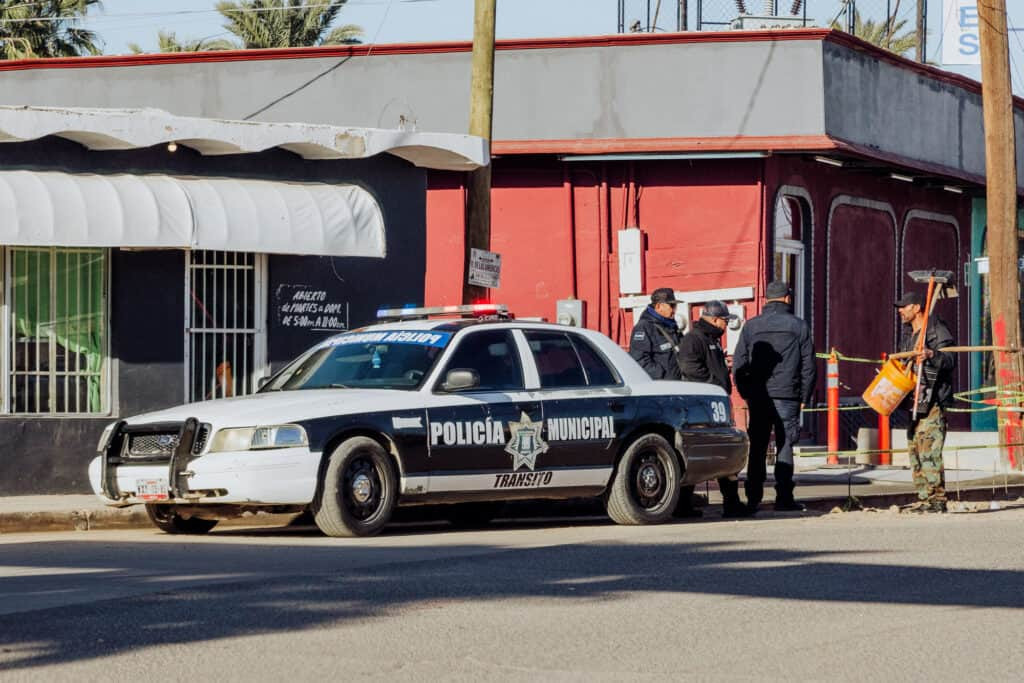 Mexican Police in Sonoyta
Mexican Police in Sonoyta
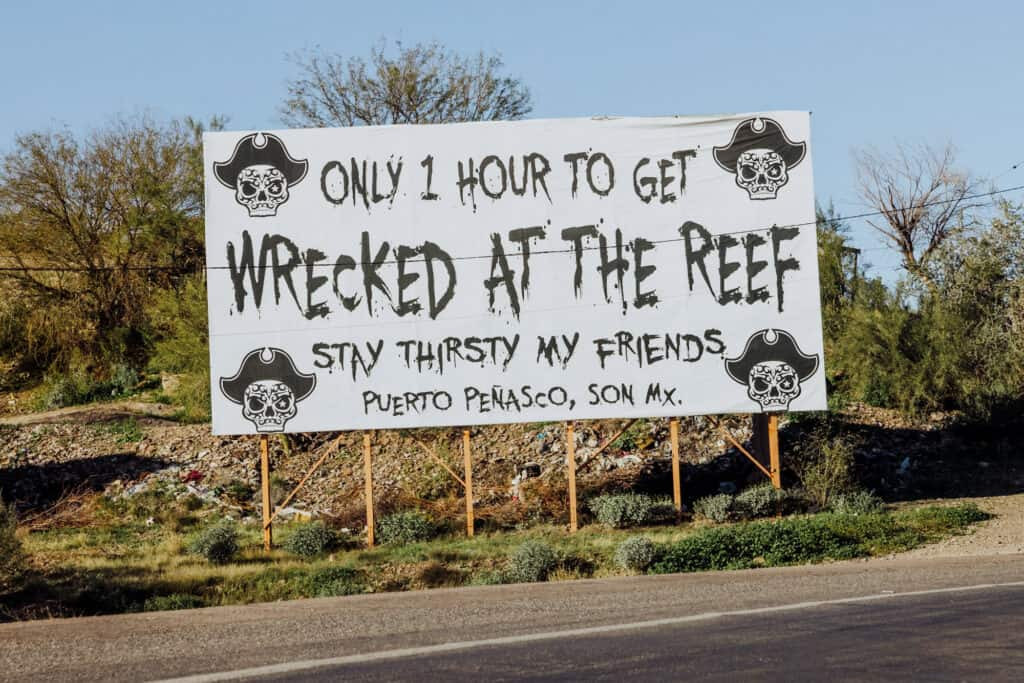 Wrecked at the Reef Bar Sign near Rocky Point
Wrecked at the Reef Bar Sign near Rocky Point
Lukeville Border Closure in 2023: What Happened?
In December 2023, the Lukeville Port of Entry unexpectedly closed to both pedestrian and vehicle traffic. This closure was not due to safety concerns in Rocky Point itself.
U.S. Customs and Border Protection (CBP) temporarily reassigned officers and staff from Lukeville to assist Border Patrol with a surge of migrants at other points along the southern border.
The closure lasted about a month, with Lukeville reopening on January 4, 2024. This temporary shutdown had a significant economic impact on Rocky Point, as tourism drastically declined.
Travelers had to reroute through Nogales or San Luis, adding considerable time to their journeys. For example, the drive from Phoenix to Rocky Point via San Luis (Yuma area) is approximately 6 hours, and via Nogales, it’s over 7 hours.
It’s important to reiterate that the border closure was due to migrant processing needs, not violence or safety issues in Rocky Point or along Highway 8.
Is Driving in Mexico Safe in 2024? General Advice
Generally, driving in tourist areas of Mexico during daylight hours can be safe for Americans, especially when sticking to recommended routes like Highway 8 to Rocky Point.
The Yucatán Peninsula is often cited as the safest region in Mexico for driving, home to popular destinations like Cancun, Tulum, Merida, and Valladolid.
However, the U.S. State Department advises against driving in many other parts of Mexico. For instance, a road trip along the coast from Mazatlan to Puerto Vallarta is currently not recommended. For such destinations, flying is generally a safer option.
Tips for Renting a Car and Driving in Mexico:
- Travel with a Spanish speaker: Communication can be significantly easier with a Spanish speaker.
- Carry cash, but distribute it: Have cash for tolls and small purchases, but avoid keeping large sums in one place.
- Never transport drugs or firearms: Strictly avoid carrying any illegal substances or weapons.
- Adhere to traffic laws: Drive slowly and respect speed limits.
- Travel in daylight: Minimize driving at night.
- Expect police checkpoints: Be prepared for potential stops by law enforcement.
Personal Experience: A Reminder to Stay Vigilant
While many trips to Mexico are uneventful, it’s wise to be aware of potential issues, even in tourist areas. One personal experience serves as a reminder to remain cautious.
Two years ago, driving in the Tulum area after dark, the author was stopped at an unlit police checkpoint. Despite having all proper documentation for a rental car, corrupt federal police officers fabricated allegations and ultimately stole cash.
The incident, while unsettling and resulting in a loss of around $200, was a stark reminder of the importance of caution, especially driving at night. While the situation was resolved without further escalation, it underscores the advice to drive during daylight and adhere to traffic laws to minimize potential risks.
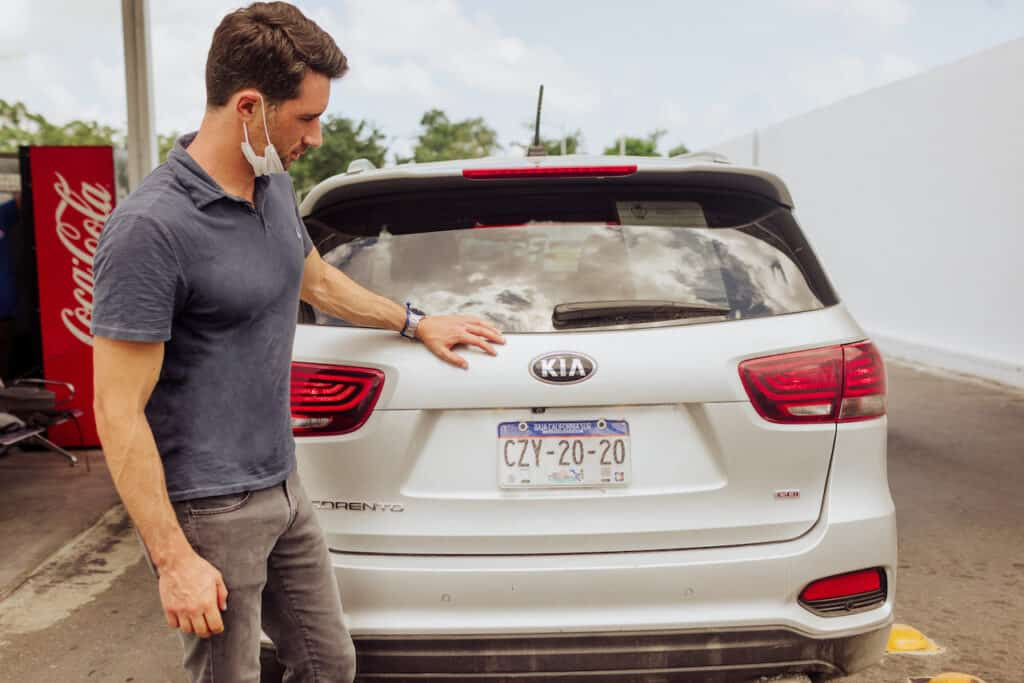 Rental SUV in Mexico
Rental SUV in Mexico
Conclusion: Safe Travel to Rocky Point is Possible
Ultimately, travel always involves a degree of risk. Staying informed and making well-considered decisions is key to safe and enjoyable travel.
Despite concerns about safety in Mexico, tourist destinations like Cancun are currently experiencing high visitor numbers, exceeding pre-pandemic levels. This indicates that many travelers are not deterred by generalized safety advisories and are enjoying their Mexican vacations.
For Rocky Point, sticking to Highway 8, driving during daylight, and practicing common-sense safety measures can significantly mitigate risks. By staying informed and prepared, a safe and memorable trip to Rocky Point, Sonora, Mexico, is absolutely achievable in 2024.
Explore More About Rocky Point:
- Las Palomas, Rocky Point
- 30 Things to do in Rocky Point
- Rocky Point Beaches
- Top 12 Rocky Point Resorts